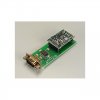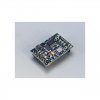Hello. I want to interface an electronic compass that uses a UART module to a 16F877. However, the compass can be either supplied as it is on a PCB with the RC, TX, GND,.... pins available for attachment (welding), or I can get it with an RS232 port attached to it so that I can get an RS232 cable. I am not sure how to interface it in either way. Which is a better option?? In the second option, I'll attach an RS232 cable to the port, strip the wires, and solder them to the PIC pins?! And in the first option, I weld the compass pins directly to the PIC? Please help. Thanks.



